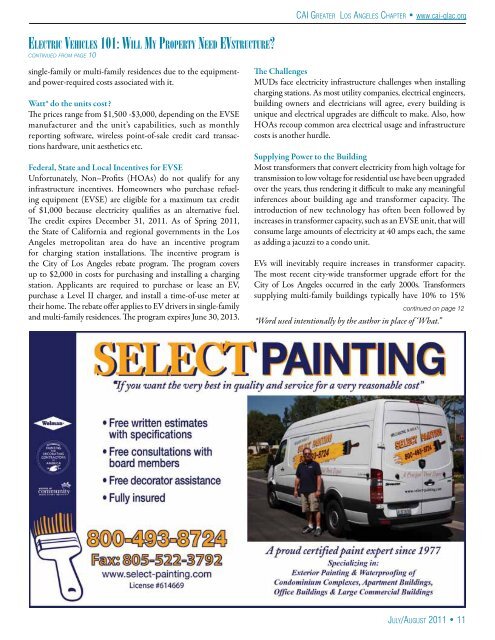Download this publication as PDF - CAI - Greater Los Angeles Chapter
Download this publication as PDF - CAI - Greater Los Angeles Chapter
Download this publication as PDF - CAI - Greater Los Angeles Chapter
Create successful ePaper yourself
Turn your PDF publications into a flip-book with our unique Google optimized e-Paper software.
<strong>CAI</strong> GreAter <strong>Los</strong> AnGeLes ChApter • www.cai-glac.orgeLeCTriC vehiCLes 101: wiLL my properTy neeD evsTrUCTUre?continued from page 10single-family or multi-family residences due to the equipmentandpower-required costs <strong>as</strong>sociated with it.Watt* do the units cost?The prices range from $1,500 -$3,000, depending on the EVSEmanufacturer and the unit’s capabilities, such <strong>as</strong> monthlyreporting software, wireless point-of-sale credit card transactionshardware, unit aesthetics etc.Federal, State and Local Incentives for EVSEUnfortunately, Non–Profits (HOAs) do not qualify for anyinfr<strong>as</strong>tructure incentives. Homeowners who purch<strong>as</strong>e refuelingequipment (EVSE) are eligible for a maximum tax creditof $1,000 because electricity qualifies <strong>as</strong> an alternative fuel.The credit expires December 31, 2011. As of Spring 2011,the State of California and regional governments in the <strong>Los</strong><strong>Angeles</strong> metropolitan area do have an incentive programfor charging station installations. The incentive program isthe City of <strong>Los</strong> <strong>Angeles</strong> rebate program. The program coversup to $2,000 in costs for purch<strong>as</strong>ing and installing a chargingstation. Applicants are required to purch<strong>as</strong>e or le<strong>as</strong>e an EV,purch<strong>as</strong>e a Level II charger, and install a time-of-use meter attheir home. The rebate offer applies to EV drivers in single-familyand multi-family residences. The program expires June 30, 2013.The ChallengesMUDs face electricity infr<strong>as</strong>tructure challenges when installingcharging stations. As most utility companies, electrical engineers,building owners and electricians will agree, every building isunique and electrical upgrades are difficult to make. Also, howHOAs recoup common area electrical usage and infr<strong>as</strong>tructurecosts is another hurdle.Supplying Power to the BuildingMost transformers that convert electricity from high voltage fortransmission to low voltage for residential use have been upgradedover the years, thus rendering it difficult to make any meaningfulinferences about building age and transformer capacity. Theintroduction of new technology h<strong>as</strong> often been followed byincre<strong>as</strong>es in transformer capacity, such <strong>as</strong> an EVSE unit, that willconsume large amounts of electricity at 40 amps each, the same<strong>as</strong> adding a jacuzzi to a condo unit.EVs will inevitably require incre<strong>as</strong>es in transformer capacity.The most recent city-wide transformer upgrade effort for theCity of <strong>Los</strong> <strong>Angeles</strong> occurred in the early 2000s. Transformerssupplying multi-family buildings typically have 10% to 15%continued on page 12*Word used intentionally by the author in place of ‘What.”July/August 2011 • 11


